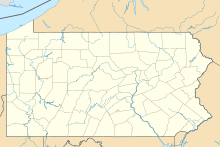| American Civil War | |||||||
|---|---|---|---|---|---|---|---|
| Part of Ewell's demonstration, Battle of Gettysburg | |||||||
| |||||||
| Belligerents | |||||||
| Confederate | Union | ||||||
| Commanders and leaders | |||||||
| Richard S. Ewell | Oliver O. Howard | ||||||
| Units involved | |||||||
| Louisiana Tigers Brigade | |||||||
| Casualties and losses | |||||||
| Heavy | |||||||
Location within Pennsylvania | |||||||
The battle of East Cemetery Hill[2] during the American Civil War was a military engagement on the second day of the Battle of Gettysburg, in which an attack of the Confederacy's Louisiana Tigers Brigade and a brigade led by Colonel Robert Hoke was repelled by the forces of Colonel Andrew L. Harris and Colonel Leopold von Gilsa of the XI Corps (Union Army), plus reinforcements. The site is on Cemetery Hill's east-northeast slope, east of the summit of the Baltimore Pike.
Confederate General Robert E. Lee assigned Lt. Gen. Richard S. Ewell's Second Corps to launch a demonstration against the Union right to distract the Army of the Potomac during Longstreet's attack to the south-southwest (Hood's Assault, McLaws' Assault, and Anderson's assault). Ewell was to exploit any success his demonstration might achieve by following up with a full-scale attack at his discretion.[3] Preceded by a 4 p.m. artillery barrage from Benner Hill, the demonstration's infantry attack commenced with Johnson's Assault on Culp's Hill. The Union artillery lunettes on East Cemetery Hill provided protection from the barrage, and the counterbattery fire on Ewell's 4 batteries forced them to withdraw with heavy[specify] casualties (e.g., Major Joseph W. Latimer).[3]

Baltimore Pike: Artillery lunettes downhill and along the east of the pike were uphill of the Union infantry line at the Brickyard Lane stone wall.
Northwest: Maj. Gen. Robert Rodes's division along the dirt path (now Long Lane) in the darkness was not ready to attack a different side of Cemetery Hill until the east battle was almost over.
- ^ Swain, Craig (March 15, 2009). "Major General Oliver Otis Howard" (HMdb.org webpage, marker 17043). Retrieved 2011-11-20.
- ^ "Gettysburg - East Cemetery Hill - July 2, 1863" (map & battle description). Maps of Gettysburg, Pennsylvania (1863). Civil War Trust. Retrieved 2011-11-19.
- ^ a b Cite error: The named reference
Pfanz1987was invoked but never defined (see the help page).
